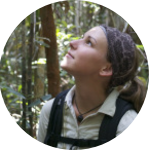About This Project
Orangutans are close to extinction due to habitat loss. Southeast Asia has the highest rate of deforestation in the tropics, with less than 10% of forests under some form of protection. This research aims to discover if monitoring levels of nutritional stress in orangutans can proved a quicker and less labor-intensive method for detecting forest degradation.Ask the Scientists
Join The DiscussionWhat is the context of this research?
Typically, conservationists use the presence, absence, or
density of “indicator species” - animals that are sensitive to habitat disturbance - to provide an early warning of environmental impacts to the habitat as the whole. Individual orangutans make ideal indicators for rainforests. Their diet consists of a large quantity and variety of plants and invertebrates and are consequently sensitive to disturbances in their forest homes.
Orangutans reproduce very slowly, this means it can take a long time for the population to recover once it declines. This means it may be too late to take action to conserve the species and once declines are observed.
Because the body condition of an individual orangutan depends on the quality of their habitat, effective methods for monitoring potential variations in the body condition of the animal due to diet could be a useful indicator of habitat condition. Glucocorticoids and T3 thyroid hormones indicate short and long-term nutritional stress. These can be detected in fecal samples, which can be reliably collected while following orangutans. By measuring hormone levels, we may be able to determine if orangutans are suffering from nutritional stress due to forest degradation
What is the significance of this project?
Rainforests will disappear from the global landscape within
the next hundred years if current deforestation rates continue. Southeast Asia currently has the highest rate of tropical deforestation, and it continues to accelerate each year. Conservation efforts for orangutans would greatly benefit from more effective and sensitive methods for detecting changes in habitat condition much earlier.
Non-invasive measuring of stress hormone levels in indicator species has yet to be validated as a conservation tool, but may provide a more rapid and less labor-intensive method for estimating population-level stress before population declines are seen. This in turn will indicate forest condition and will provide a more timely detection of forest disturbances, which can lead to a more rapid response by conservation managers. Such responses might include timely adjustments in protection regulations and patrols.
What are the goals of the project?
The goal of this project is to determine the extent to which
measured nutritional stress in orangutans can be used as an early warning of forest degradation.
- To establish if nutritional stress can be detected in orangutan feces by measuring glucocorticoids and T3 thyroid hormones.
- To determine if nutritional stress is caused by a decline in food availability.
- To collect and analyze 64 fecal samples from flanged male orangutans.
- To monitor the levels of Glucocorticoids and T3 thyroid hormones, both of which (T3 in particular) can indicate nutritional stress.
- To gather botanical data in the Natural laboratory of Peat-Swamp Forest, in the Sabangau rainforest, Central Kalimantan, Indonesia.
- Compare the fecal sample results with various kinds of data on forest quality, including phenological data, results from litter-fall traps and mortality rates of tree and liana species.
- To establish whether monitoring orangutan nutritional stress could be a useful new early warning indicator for declines in forest quality, allowing earlier appropriate intervention to take conservation measures.
Budget
These funds are required to analyse the fecal samples from wild orangutans. The funds requested will be used to process the samples collected in Indonesia, for transferring the samples to the lab, and for the collecting permit fees.
Meet the Team
Team Bio
I developed my passion for orangutans and forestconservation when I completed a research internship with OuTrop in 2011. After my internship, I returned to the Sabangau Forest to conduct my PhD research. When I am not running around the peat-swamp forest, I enjoy outdoor activities such as hiking, rock climbing, and traveling.
OuTrop is a research and conservation organization based in the Sabangau rainforest in the heart of Indonesian Borneo. Since 1999, OuTrop has run a variety of projects to help understand and protect peat-swamp rainforests and the wildlife they are home to. Their primary research focuses on orangutans, southern Bornean gibbons and red langur monkeys. Through ecological monitoring with local partners, OuTrop strives to develop conservation solutions and improve capacity for conservation in the region. OuTrop has already accomplished great strides in conservation with the assistance of a local patrol team to stop illegal logging and has been conducting orangutan research for 12 years.
For a publication list or more information, please visit www.outrop.com
Additional Information
Meet the OuTrop Research Team!
We are a mix of over 15 local Indonesian and over 6 western staff at any given time.
Of course our most important member of camp, Ball Pen!

Here is our base camp, the Natural Laboratory, based 1.5 km into the forest from the river that separates the Sabangau Forest from the nearest village.


Project Backers
- 19Backers
- 25%Funded
- $814Total Donations
- $42.84Average Donation
